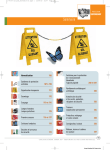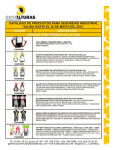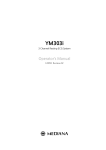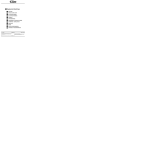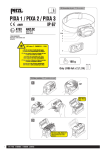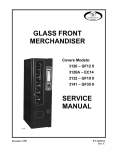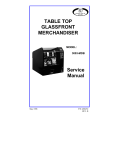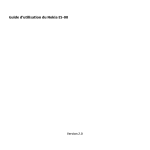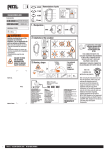Download Petzl Vertex Best Helmet
Transcript
marquage Traceability(text andpart) markings / Traçabilité et marquage Field of application Champ d’application (partie texte) ® vidual number 1. Preparation / Préparation Individual number 3 year guarantee 0 AA 0000 Patented 3 year guarantee Nomenclature of parts / Nomenclature VERTEX BEST (EN) Helmet for work at height and rescue. (FR) Casque pour les travaux en hauteur et les secours. e 00 000 AA 00002. Adjustments / Réglages 7 9 3 TRACEABILITY: 0082 4 5 0082 ANSI/ISEA Z89.1-2009 type 1 class E SGS United Kingdom Ltd., Weston-super-Mare, BS22 6WA, UK. (Notified body N°0120) Body controlling the manufacture of this PPE 0082 APAVE SUD Europe SAS BP3 - 33370 ARTIGUES PRES BORDEAUX - France N°0082 2b. ANSI/ISEA Z89.1 SGS United Kingdom Ltd., Notified body that carried Weston-super-Mare, BS22 out the CE type inspection 6WA, UK. (Notified body N°0120) WARNING EN 397 Low temperature use : -30°C Electrical insulation : 440 V a.c. Lateral deformation : LD Molten metal splash : MM Activities involving the use of this equipment are inherently dangerous. You are responsible for your own actions and decisions. Before using this equipment, you must: - Read and understand all Instructions for Use. - Get specific training in its proper use. - Become acquainted with its capabilities and limitations. - Understand and accept the risks involved. size A165060D (110211) miniplan 1 recto FAILURE TO HEED ANY OF THESE WARNINGS MAY RESULT IN SEVERE INJURY OR DEATH. anguages Product Experience 53 20,9 63 cm 24,8 inch 455 g 2c. www.petzl.com Latest version Other languages Product Experience 77 mm 76 mm ZI Cidex 105A 38920 Crolles France www.petzl.com/contact 75 mm ISO 9001 Copyright Petzl 1. Preparation / Préparation 2. Adjustments / Réglages 1 2a. 6 2d. 2 4 5 Open Close 2b. Clic! 2e. 8 2c. A16_VERTEX_BEST_A165060D (110211) FAIL RES Instructions for use / Mode d’emploi Nomenclature of parts / Nomenclature CAHIER Inspection, points to verify (text part) Contrôle, points à vérifier (partie texte) PETZL PRICE Field of application (text part) Champ d’application (partie texte) Inspection, points to verify (text part) Contrôle, points à vérifier (partie texte) B - Rea - Become -U 8 A165060D (110211) miniplan 1 recto 455 g Activities involving t You are resp CAHIER -30°C 40 V a.c. D MM 9 3 (EN) Helmet for wor at height and rescue (FR) Casque pour les en hauteur et les sec datamatrix = product reference + individual number 2 APAVE SUD Europe SAS BP3 - 33370 ARTIGUES PRES BORDEAUX - France N°0082 7 VERTE 2a. Year of 1 manufacture Day of manufacture Control or name 6 of inspector Incrementation erence + individual number 1 Instructions for use / Mode d’emploi Instructions for use / Mode d’emploi 3. Test / test Accessories / Accessoires Spare parts / Pièces détachées Attaching hearing protection / Fixation des protections antibruit Replacement foam for VERTEX Mousse de rechange pour VERTEX A10210 Attaching Clippage for which it is not designed. Activities at height present a risk of serious head injury. Wearing a helmet can significantly reduce this risk, but cannot entirely eliminate it. In a major impact, the helmet deforms to absorb the maximum amount of energy possible, sometimes to the point of destroying the helmet. WARNING Activities involving the use of this equipment are inherently dangerous. You are responsible for your own actions and decisions. Before using this product, you must: - Read and understand all instructions for use. - Get specific training in its proper use. - Become acquainted with its capabilities and limitations. - Understand and accept the risks involved. Failure to heed any of these warnings may result in severe injury or death. Responsibility WARNING, specific training in the activities defined in the field of application is essential before use. This product must only be used by competent and responsible persons, or those placed under the direct and visual control of a competent and (EN) ENGLISH Helmet for work at height and rescue Removing Déclippage Absorbent foam for VERTEX Mousse absorbante pour VERTEX A10200 Standard stickers for VERTEX Autocollants standards pour VERTEX A10100 Reflective stickers for VERTEX Autocollants réfléchissants pour VERTEX 80 mm A10110 bt t. + 50°C / + 122°F - 30°C / - 22°F L nt e ht d on on A165060D (110211) miniplan 1 verso o 2 A16_VERTEX_BEST_A165060D (110211) Mounting the headlamp / Fixation de la lampe frontale PIXA 1: E78AHB PIXA 2: E78BHB PIXA 3: E78CHB A165060D (110211) CAHIER VIZIR face shield / Visière VIZIR A15 Field of application This helmet is designed only for work at height and rescue. The VERTEX BEST meets all requirements of the EN 397 standard, except for the chin strap. The chinstrap has a strength of 50 daN (requirement of the EN 12492 standard) to help keep the helmet on the head in case of a fall. The VERTEX BEST meets optional requirements of EN 397: Protection against impacts down to -30 °C, resistance to lateral deformation, protection against accidental contact with live conductors up to 440 V AC and protection against molten metal splash. Electrical standards: - EN 397: this helmet protects against accidental contact with live conductors up to 440 V AC. - ANSI Z89.1-2009 class E: The helmet was tested at a voltage of 20000 V, but this does not in any way guarantee protection against electric shocks at this voltage. The standard guarantees protection against electric shocks resulting from accidental contact between the helmet and a live electric device. Do not use this helmet in activities 1 (EN) ENGLISH Petzl general information Helmet for work at height and rescue Lifetime / When to retire your equipment Field of application This helmet is designed only for work at height and rescue. The VERTEX BEST meets all requirements of the EN 397 standard, except for the chin strap. The chinstrap has a strength of 50 daN (requirement of the EN 12492 standard) to help keep the helmet on the head in case of a fall. The VERTEX BEST meets optional requirements of EN 397: Protection against impacts down to -30 °C, resistance to lateral deformation, protection against accidental contact with live conductors up to 440 V AC and protection against molten metal splash. Electrical standards: - EN 397: this helmet protects against accidental contact with live conductors up to 440 V AC. - ANSI Z89.1-2009 class E: The helmet was tested at a voltage of 20000 V, but this does not in any way guarantee protection against electric shocks at this voltage. The standard guarantees protection against electric shocks resulting from accidental contact between the helmet and a live electric device. Do not use this helmet in activities for which it is not designed. Activities at height present a risk of serious head injury. Wearing a helmet can significantly reduce this risk, but cannot entirely eliminate it. In a major impact, the helmet deforms to absorb the maximum amount of energy possible, sometimes to the point of destroying the helmet. WARNING Activities involving the use of this equipment are inherently dangerous. You are responsible for your own actions and decisions. Before using this product, you must: - Read and understand all instructions for use. - Get specific training in its proper use. - Become acquainted with its capabilities and limitations. - Understand and accept the risks involved. Failure to heed any of these warnings may result in severe injury or death. Responsibility WARNING, specific training in the activities defined in the field of application is essential before use. This product must only be used by competent and responsible persons, or those placed under the direct and visual control of a competent and responsible person. Gaining an adequate apprenticeship in appropriate techniques and methods of protection is your own responsibility. You personally assume all risks and responsibilities for all damage, injury or death which may occur during or following incorrect use of our products in any manner whatsoever. If you are not able, or not in a position to assume this responsibility or to take this risk, do not use this equipment. Nomenclature of parts (1) Shell, (2) Headband, (3) Headband adjustment wheels, (4) Chin strap positioning buckles, (5) Chin strap fastening and adjustment buckle, (6) Side slots for mounting hearing protection, (7) Headlamp clips, (8) Front headlamp mounting slot, (9) Face shield mounting hole. Principal materials: Acrylonitrile Butadiene Styrene (ABS) shell, polyester straps. Inspection, points to verify Before each use, check the condition of the shell and the headband attachment system (verify there are no cracks or deformation on the outside or the inside...). Check the condition of the webbing and stitching. Verify that the headband adjustment system and chinstrap buckle are functioning properly. WARNING, a major impact to the helmet can significantly reduce its protective properties without leaving visible signs of damage. Retire your helmet after a major impact. Consult the details of the inspection procedure to be carried out for each item of PPE on the Web at www.petzl.com/ppe Contact PETZL if there is any doubt about the condition of this product. Instructions for use 1. Preparation Use only the smooth areas for stickers and other markings. PETZL stickers are approved. Do not apply paint, solvents, adhesives or self-adhesive labels, except those recommended by PETZL instructions. (Paint is prohibited on CSA Z94.1-05 type 1 class E helmets.) 2. Adjustments 2a. Adjust the headband to maximum size using the adjustment wheels and place the helmet on your head. 2b. Position the adjusters under the ears. To adjust the chinstrap backwards or forwards, slide the webbing through the chinstrap positioning buckles. 2c. Use the adjustment wheels to increase or decrease the size of the headband. You can adjust the height of the headband on your forehead (two adjustment holes for the vertical position of the headband). 2d. Fasten the chinstrap using the buckle. You must hear the buckle “click” to ensure proper fastening. Tighten the chinstrap to fit comfortably. A correctly adjusted chinstrap reduces the risk of the helmet coming off accidentally. You must pull on the chinstrap to verify that the buckle is properly fastened. To open the buckle, press the button on the chinstrap fastening buckle. 2e. Adjust the vertical position of the headband adjustment system on your nape by sliding it up or down along the webbing. ATTENTION, be sure there is no slack in the webbing between the headband adjustment system and the shell of the helmet. 3. Test Verify that the helmet is well seated and centered on the head. A well-adjusted helmet (minimal movement front to back or side to side), provides better protection. Accessories - Use the side slots to attach hearing protection. Use a screwdriver to remove them. - Mounting the face shield: use the face shield mounting hole, or the side slots. - Mounting the headlamp: use the headlamp clips, or the front slot on the helmet. Precautions for use - Your helmet can be damaged from improper care. Do not sit on it, pack it too tightly, drop it, allow it to contact sharp or pointed objects, etc. Do not expose your helmet to high temperatures, for example by leaving it inside a vehicle in direct sunlight. - Certain chemical products, especially solvents, can damage your helmet. Protect your helmet from exposure to chemicals. - This helmet has been tested for use at temperatures between -30 °C and +50 °C. 3 A16_VERTEX_BEST_A165060D (110211) For Petzl’s plastic and textile products, the maximum lifetime is 10 years from the date of manufacture. It is indefinite for metallic products. ATTENTION: an exceptional event can lead you to retire a product after only one use, depending on the type and intensity of usage and the environment of usage (harsh environments, marine environment, sharp edges, extreme temperatures, chemical products, etc.). A product must be retired when: - It is over 10 years old and made of plastic or textiles. - It has been subjected to a major fall (or load). - It fails to pass inspection. You have any doubt as to its reliability. - You do not know its full usage history. - When it becomes obsolete due to changes in legislation, standards, technique or incompatibility with other equipment, etc. Destroy retired equipment to prevent further use. Product inspection In addition to the inspection before each use, an in-depth inspection must be carried out by a competent inspector. The frequency of the in-depth inspection must be governed by applicable legislation, and the type and the intensity of use. Petzl recommends an inspection at least once every 12 months. To help maintain product traceability, do not remove any markings or labels. Inspection results should be recorded on a form with the following details: type of equipment, model, manufacturer contact information, serial number or individual number, date of manufacture, date of purchase, date of first use, date of next periodic inspection, problems, comments, the name and signature of the inspector. See an example at www.petzl.com/ppe Storage, transport Decrease the size of the headband and tuck it into the helmet. Do not pack your helmet too tightly. Store the product in a dry place away from exposure to UV, chemicals, extreme temperatures, etc. Cleaning Clean the shell with soap and lukewarm water, then rinse with water. Modifications, repairs Modifications and repairs outside of Petzl facilities are prohibited (except replacement parts). 3-year guarantee Against all material or manufacturing defect. Exclusions: normal wear and tear, oxidation, modifications or alterations, incorrect storage, poor maintenance, negligence, uses for which this product is not designed. Responsibility PETZL is not responsible for the consequences, direct, indirect or accidental, or any other type of damage befalling or resulting from the use of its products. (FR) FRANÇAIS Casque pour les travaux en hauteur et les secours Champ d’application Casque conçu seulement pour les travaux en hauteur et les secours. Le VERTEX BEST satisfait aux exigences de la norme EN 397 excepté pour la jugulaire. La jugulaire a une résistance de 50 daN (exigence norme EN 12492) pour permettre au casque de rester sur la tête en cas de chute. Le VERTEX BEST répond aux exigences facultatives de la norme EN 397: protection contre les chocs jusqu’à -30 °C, résistance à la déformation latérale, protection contre un contact accidentel avec des conducteurs sous tension pouvant atteindre 440 V alternatif et protection contre les projections de métaux en fusion. Normes électriques : - EN 397: ce casque protège contre un contact accidentel avec des conducteurs sous tension pouvant atteindre 440 V alternatif. - ANSI Z89.1-2009 class E : le casque a été testé à une tension de 20000 V, mais cela ne garantit en aucun cas une protection contre des chocs électriques à cette tension. La norme garantit une protection contre les chocs électriques, suite à un contact accidentel entre le casque et un appareil électrique sous tension. N’utilisez pas ce casque lors d’activités pour lesquelles il n’a pas été conçu. La pratique d’activités en hauteur comporte des risques graves pour la tête. Le port du casque réduit fortement ces risques, mais il ne peut pas les exclure. Pour des chocs très violents, le casque absorbe le maximum d’énergie en se déformant, parfois jusqu’à la rupture. ATTENTION Les activités impliquant l’utilisation de ce produit sont par nature dangereuses. Vous êtes responsable de vos actes et de vos décisions. Avant d’utiliser ce produit, vous devez : - Lire et comprendre toutes les instructions d’utilisation. - Vous former spécifiquement à l’utilisation de ce produit. - Vous familiariser avec votre produit, apprendre à connaître ses performances et ses limites. - Comprendre et accepter les risques induits. Le non-respect d’un seul de ces avertissements peut être la cause de blessures graves ou mortelles. Responsabilité ATTENTION, une formation, adaptée aux pratiques définies dans le champ d’application, est indispensable avant utilisation. Ce produit ne doit être utilisé que par des personnes compétentes et avisées, ou placées sous le contrôle visuel direct d’une personne compétente et avisée. L’apprentissage des techniques adéquates et des mesures de sécurité s’effectue sous votre seule responsabilité. Vous assumez personnellement tous les risques et responsabilités pour tout dommage, blessure ou mort pouvant survenir suite à une mauvaise utilisation de nos produits de quelque façon que ce soit. Si vous n’êtes pas en mesure d’assumer cette responsabilité ou de prendre ce risque, n’utilisez pas ce matériel. Nomenclature (1) Calotte, (2) Tour de tête, (3) Molettes de réglage du tour de tête, (4) Boucles d’ajustement de la jugulaire, (5) Boucle de fermeture et de serrage de la jugulaire, (6) Fentes latérales pour fixation des protections antibruit, (7) Crochets pour lampe frontale, (8) Fente avant pour fixation de la lampe, (9) Trou de fixation de la visière. Matériaux principaux : calotte en Acrylonitrile Butadiène Styrène (ABS), sangles en polyester. Contrôle, points à vérifier Avant toute utilisation, vérifiez l’état de la calotte et du système de fixation du tour de tête (absence de fissures, déformations à l’extérieur ou à l’intérieur…). Contrôlez l’état des sangles et des coutures. Contrôlez le bon fonctionnement du réglage du tour de tête et de la boucle de la jugulaire. ATTENTION, après un choc important, des ruptures internes non apparentes peuvent diminuer la capacité d’absorption et la résistance du casque. Mettez votre casque au rebut après un choc important. Consultez le détail du contrôle à effectuer pour chaque EPI sur le site www.petzl. fr/epi En cas de doute, contactez PETZL. Mode d’emploi 1. Préparation Utilisez uniquement les zones lisses pour vos autocollants et marquages personnalisés. Les autocollants PETZL sont autorisés. N’appliquez pas de peintures, solvants, adhésifs ou étiquettes autocollantes, à l´exception de ceux recommandés par les instructions PETZL. (Pour les casques version CSA Z94.1-05 type 1 class E, la peinture sur le casque est interdite.) 2. Réglages 2a. Élargissez le tour de tête à l’aide des molettes de réglage et placez votre casque sur votre tête. 2b. Positionnez les boucles sous les oreilles. Pour ajuster la jugulaire (avant arrière) faites coulisser la sangle dans les boucles d’ajustement de la jugulaire. 2c. Ajustez le tour de tête avec les molettes de réglage pour diminuer ou augmenter la taille. Vous pouvez ajuster la hauteur de la position du tour de tête sur votre front (deux trous de réglage pour la position verticale du tour de tête). 2d. Fermez la jugulaire à l’aide de la boucle de fermeture. Vous devez entendre un clic de blocage. Serrez la jugulaire de façon confortable. Une jugulaire bien serrée limite le risque de décoiffement. Vous devez tirer sur la jugulaire pour vérifier que la boucle soit bien fermée. Pour ouvrir la boucle, pressez le bouton de la boucle de fermeture de la jugulaire. 2e. Ajustez la position verticale du système de réglage du tour de tête en le descendant plus ou moins sur la nuque. ATTENTION, veillez à ce qu’il n’y ait pas de mou de sangle entre le système de réglage et la calotte. 3. Test Vérifiez que le casque soit bien fixé et centré sur la tête. Au mieux un casque est ajusté (mouvements avant, arrière, latéral réduits), au mieux il assure la sécurité. Accessoires - Fixation des protections antibruit : utilisez les fentes latérales. Utilisez un tournevis pour les retirer. - Fixation de la visière : utilisez le trou de fixation de la visière, ou les fentes latérales. - Fixation de la lampe frontale : utilisez les crochets pour lampe frontale, ou la fente avant du casque. Précautions d’usage - Les casques sont sensibles aux mauvais traitements. Ne vous asseyez pas dessus, ne les comprimez pas dans le sac, ne les laissez pas tomber, ne les mettez pas en contact avec des objets pointus ou coupants… N’exposez pas votre casque à des températures élevées, par exemple en plein soleil dans une voiture. - Certains produits chimiques, en particulier les solvants, altèrent les qualités physiques de votre casque. Protégez votre casque de ce type de projections. - Ce casque a été testé pour être utilisé à des températures comprises entre -30 °C et +50 °C. Généralités Petzl Durée de vie / Mise au rebut Pour les produits Petzl, plastiques et textiles, la durée de vie maximale est de 10 ans à partir de la date de fabrication. Elle n’est pas limitée pour les produits métalliques. ATTENTION, un événement exceptionnel peut vous conduire à rebuter un produit après une seule utilisation (type et intensité d’utilisation, environnement d’utilisation : milieux agressifs, milieu marin, arêtes coupantes, températures extrêmes, produits chimiques, etc.). Un produit doit être rebuté quand : - Il a plus de 10 ans et est composé de plastique ou textile. - Il a subi une chute importante (ou effort). - Le résultat des vérifications du produit n’est pas satisfaisant. Vous avez un doute sur sa fiabilité. - Vous ne connaissez pas son historique complet d’utilisation. - Quand son usage est obsolète (évolution législative, normative, technique ou incompatibilité avec d’autres équipements, etc.). Détruisez ces produits pour éviter une future utilisation. Vérification du produit En plus des contrôles avant chaque utilisation, faites réaliser une vérification approfondie par un vérificateur compétent. Cette fréquence de la vérification doit être adaptée en fonction de la législation applicable, du type et de l’intensité d’utilisation. Petzl vous conseille une vérification au minimum tous les 12 mois. Ne retirez pas les étiquettes et marquages pour garder la traçabilité du produit. Les résultats des vérifications doivent être enregistrés sur une fiche de suivi : type, modèle, coordonnées fabricant, numéro de série ou numéro individuel, dates : fabrication, achat, première utilisation, prochains examens périodiques ; notes : défauts, remarques ; nom et signature du contrôleur. Voir exemple sur www.petzl.fr/epi Stockage, transport Rabattez le tour de tête à l’intérieur du casque après l’avoir réduit. Ne comprimez pas votre casque. Stockez le produit au sec à l’abri des UV, produits chimiques, dans un endroit tempéré, etc. Nettoyage Nettoyez la calotte au savon et à l’eau tiède, puis rincez à l’eau. Modifications, réparations Les modifications et réparations sont interdites hors des ateliers de Petzl (sauf pièces de rechange). Garantie 3 ans Contre tout défaut de matière ou fabrication. Sont exclus : usure normale, oxydation, modifications ou retouches, mauvais stockage, mauvais entretien, négligences, utilisations pour lesquelles ce produit n’est pas destiné. Responsabilité PETZL n’est pas responsable des conséquences directes, indirectes, accidentelles ou de tout autre type de dommages survenus ou résultant de l’utilisation de ses produits.





